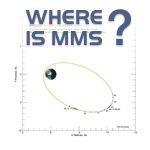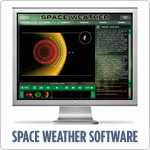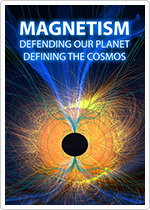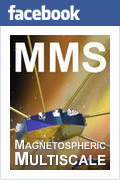AURORAL DICTIONARY
Revised: 01-11-12
Note: for a good introduction to the magnetosphere with many more terms and diagrams, please see http://www.phy6.org/Education/index.html and its glossary http://www.phy6.org/Education/gloss.html
- Active Region: Region of the Sun's surface and corona with strong magnetic fields, generally a sunspot group, which can cause a solar flare. Is bright when observed in UV and X-ray light.
- Aurora: (From Latin "dawn") Glowing lights in the sky from bombardment from electrons or protons accelerated in the Earth's magnetosphere. The particles excite the atoms and molecules, which then emit light to drop back to an unexcited state.
- Aurora australis: "southern dawn" - Aurora in the Southern hemisphere
- Aurora borealis: "northern dawn" - Aurora in the Northern hemisphere
- Auroral blue line: 391.4 nm (3914 Ångstroms), caused by band emission from molecular Nitrogen.
- Auroral curtains: Sheets of light, vertically aligned with the local magnetic field and stretching generally east to west (very thin in the north-south direction). Can have folds.
- Auroral green line: 557.7 nm (5577 Ångstroms) - caused by excited atomic Oxygen in the upper atmosphere. A forbidden line.
- Auroral oval: Instantaneous ring of the aurora around the north and south magnetic poles
- Auroral rays: Individual glowing lines, aligned with the local magnetic field direction. Named because they resemble light rays at sunset.
- Auroral red line: 630.0 nm (6300 Ångstroms) - caused by excited atomic Oxygen in the upper atmosphere.
- Auroral substorm: Violent explosive increase in auroral intensity, often moving both to higher and lower latitudes, with the curtains winding up into spirals. The auroral response to a magnetospheric substorm.
- Auroral zone: Latitude band around the Earth where statistically, auroras are most common, between about 15 and 25 degrees from the north and south magnetic poles.
- Corona (solar corona): Extremely hot outer layer of the Sun's atmosphere - millions of degrees C. Can be observed during total solar eclipses, or from space.
- Corona aurora: An auroral curtain which is overhead, so the folds make a loop around you, and the rays appear to all converge to a point above you, making a "crown".
- Coronal hole: Area in the Sun's corona where the magnetic field is "open", extending out into space, allowing the free expansion of the solar wind. This causes high speed streams that are associated with recurring aurora.
- Coronal Mass Ejection (CME): An event when part of the Sun's corona is explosively ejected into space, as a result of magnetic reconnection in the corona. Can take with it up to a million tons of material, creating a very dense, very fast solar wind. If it impacts the Earth, it can cause major geomagnetic storms with bright low latitude auroras.
- Forbidden line: Light emission from a forbidden transition. The excited atom generally will lose its energy in collisions before emitting light, so these lines are not observed in a laboratory. In the upper atmosphere, however, the density is very low and there are so few collisions that these lines can be seen.
- Geographic Pole: Location where the Earth's spin axis intersects the surface of the Earth, at the North and South.
- Geomagnetic Storm: Time of extended magnetospheric activity (1-2 days), associated with a series of auroral substorms, injection of particles into the ring current, and auroras observed closer to the equator than normal. Generally caused by a CME or a high speed stream.
- High speed streams: Regions of the solar wind that are especially high velocity (600 km/s or more) and long-lasting (a day or two). They can be associated with recurring aurora, once per solar rotation (27 days). Often are generated from coronal holes.
- Interplanetary Magnetic Field: The magnetic field, which is generated in the Sun, and extends through the solar system, to the edge of the heliosphere. Controls the access of energy and plasma to the Earth's magnetosphere through a process called magnetic reconnection.
- Magnetic Field: An invisible force that is generated by electric current loops or by changing electric fields. It acts only on moving charged particles, causing them to turn.
- Magnetic Field Line: An invisible line of force that is aligned with the local direction of the magnetic field. Since the magnetic field guides the motion of charged particles, the aurora has vertical stripes aligned with the magnetic field. Essentially you can "see" the magnetic field line by the glow from the particles trapped on it. Similarly you can "see" magnetic field lines on the Sun by the particles trapped on it. Magnetic field lines never stop or start...they exist only as loops or as lines that extend far out into space.
- Magnetic Flux Tube: A line of magnetic force that has particles associated with it. They spiral around the magnetic field line and travel up and down along the field line, but stay close to a single field line. Thus an auroral ray is the particles trapped on a single flux tube. Similarly, a field line in the Sun's corona becomes visible if it has more particles trapped on it than a neighboring field line.
- Magnetic Pole: Location where the Earth's magnetic dipole axis intersects the Earth's surface. Offset from the geographic pole by around 11 degrees of latitude, and wanders over time. The North magnetic pole the field points straight down towards the Earth. At the South magnetic pole, the magnetic field points away from the Earth.
- Magnetic Reconnection: A process whereby magnetic fields interact and join one another, releasing magnetic energy. In the process, the magnetic fields can change topologies, changing from being a closed loop to a field extended out into space or vice versa. At the Earth, a southward-pointing IMF reconnects with the northward-pointing magnetic field of the Earth, allowing energy to transfer from the solar wind to the magnetosphere.
- Magnetopause: The boundary of the magnetosphere. Nearly a parabolic shape, with the closest part being towards the Sun and a long tail away from the Sun. Separates the strong magnetic field of the Earth from the high density plasma of the solar wind. A strong electric current flows along the sheet, which increases the Earth's magnetic field inside and reduces it outside.
- Magnetosphere: The region of space dominated by the Earth's magnetic field. Starts at the upper atmosphere of Earth and extends far into space. Seen from space, it is the shape of a comet, with the nose pointing toward the Sun and the magnetotail pointing away from the Sun. The edge of the magnetosphere is the magnetopause.
- Magnetospheric Substorm: the storage and release of magnetic energy in the magnetotail. The magnetic energy builds up as a result of magnetic reconnection on the dayside magnetopause. This energy gets explosively released in the expansion phase, when magnetic reconnection in the tail allows the outer portion of the magnetic tail to break off as a plasmoid, and the inner magnetic field snaps back toward earth, becoming more like a dipole field. This slingshot accelerates and energizes plasmas, creating beautiful aurora. The energy transfer to the magnetosphere is more effective when the IMF is southward and the solar wind velocity is high, thus we can often predict violent auroras by monitoring the solar wind velocity and magnetic field.
- Magnetotail: The part of the Earth's magnetosphere that extends far downstream of the Earth, away from the Sun like a comet's tail. Extends well past the lunar distance to 250 or even 500 Earth radii. (In the sunward direction the magnetosphere is only 10-15 Earth radii in size).
- Parallel Electric Field: An electric field, aligned with the magnetic field, that allows acceleration of auroral particles to high energies. Takes an election of ~100eV energy and can accelerate it to 2-10 keV or even up above 30 keV at times. The cause of the brightest aurora.
- Plasmoid: A portion of the magnetic tail broken off by magnetic reconnection. The field, and the plasma on it, may be a closed loop, or it could be a long coil of magnetic field, called a flux rope.
- Prominence: Loop of material hanging over the Sun's surface. Often appears red because it is mostly Hydrogen.
- Solar Corona: Extremely hot outer layer of the Sun's atmosphere - millions of degrees C. Can be observed during total solar eclipses, or from space.
- Solar Cycle: A cyclic time during which the Sun goes to high activity to low activity and back again. Generally about 11 years from one maximum to the next. At solar maximum the Sun's magnetic field reverses, so the solar magnetic cycle is actually 22 years.
- Solar Energetic Particles (SEP): Very energetic particles that travel at nearly the speed of light from a solar flare. Can be dangerous to astronauts in space or to passengers on polar-flying aircraft. Very energetic so can penetrate the skin of spacecraft, unlike the solar wind which is much less energetic.
- Solar Flare: Explosion on the surface of the sun that accelerates energetic particles into space. Can also release a Coronal Mass Ejection.
- Solar Maximum: Time of high solar activity, associated with many sunspots and many flares.
- Solar Minimum: Time of low solar activity, associated with few sunspots and few flares.
- Sunspot: Cool area on the surface of the sun, seen as dark regions of in the visible band of light. Generally contains strong magnetic fields, and can be associated with active regions.






